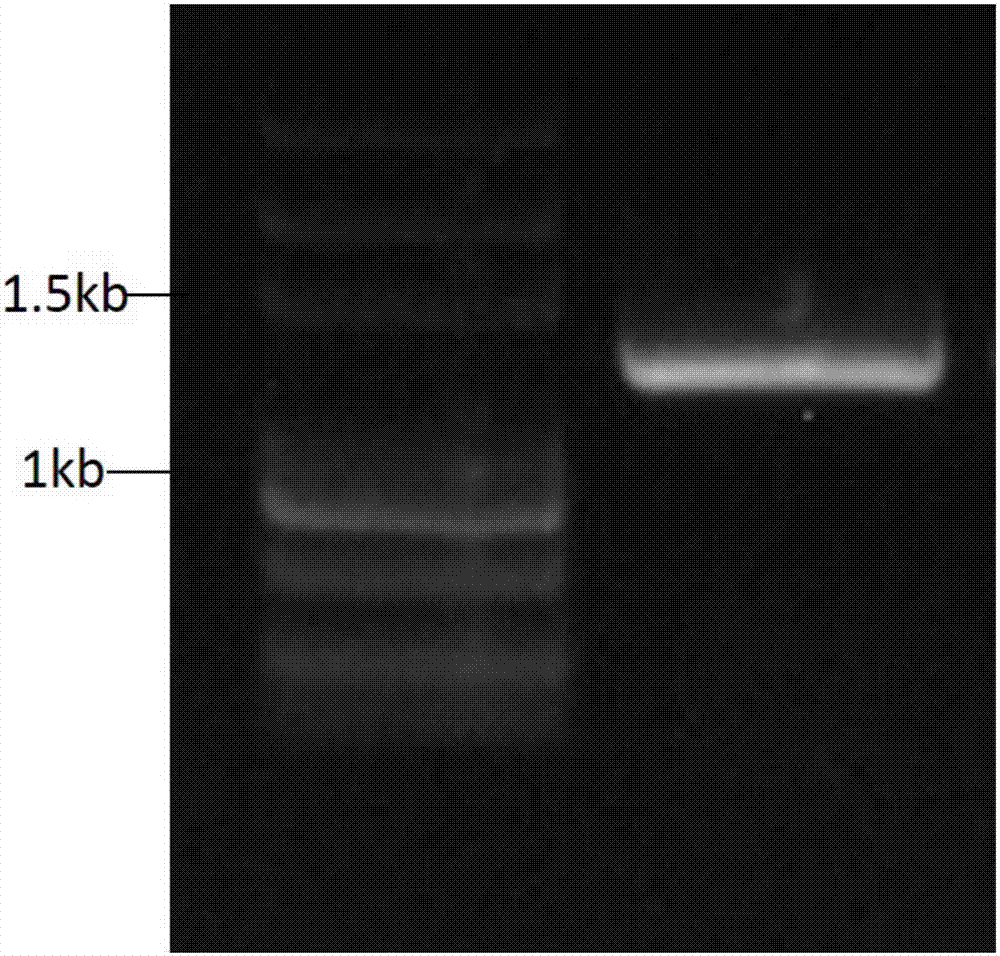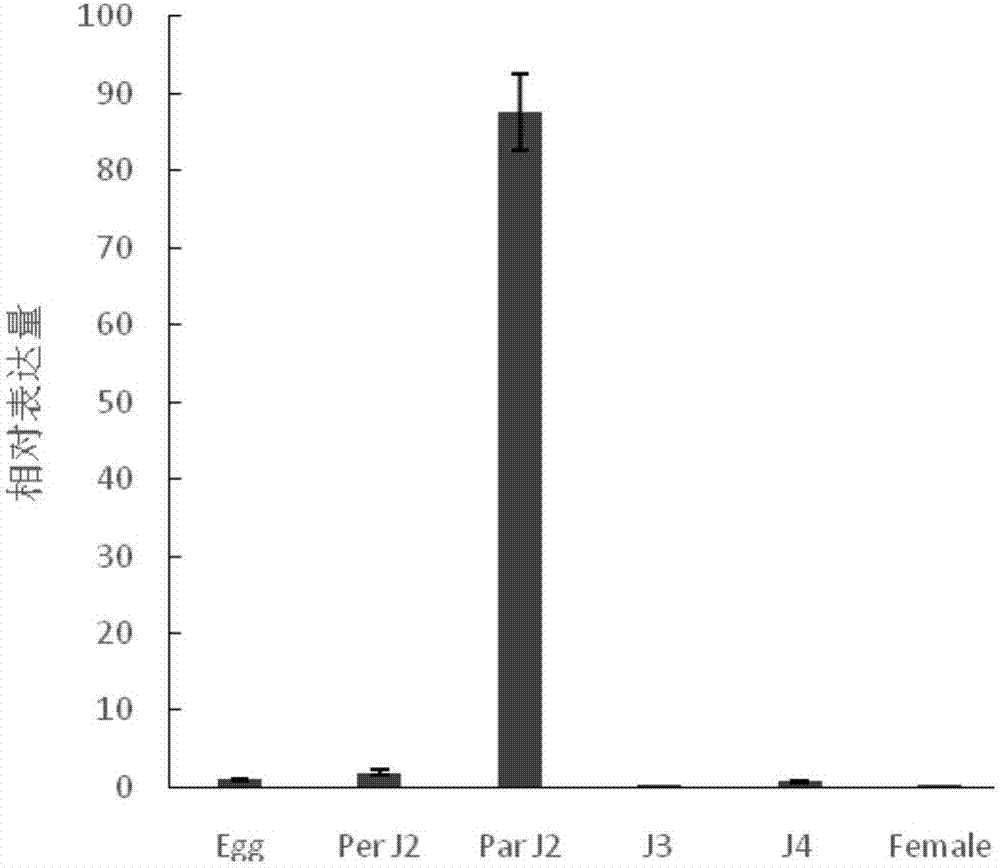Heterodera avenae Ha-16674 protein, encoding gene and application thereof
A cereal cyst nematode, ha-16674 technology, applied in the fields of application, nematicides, genetic engineering, etc., can solve problems such as the combination of inability to resist diseases and high-yield phenotypes, environmental pollution, and defects in disease-resistant varieties
- Summary
- Abstract
- Description
- Claims
- Application Information
AI Technical Summary
Problems solved by technology
Method used
Image
Examples
Embodiment 1
[0029] Embodiment 1: the acquisition of the cereal cyst nematode nematode Ha-16674 gene sequence
[0030] 1.1 Extraction of nematode total RNA
[0031]Take about 100,000 second-instar larvae, grind them thoroughly in liquid nitrogen, add 1ml Trizol reagent, and keep at room temperature for 5 minutes; add 200 μl of chloroform, mix thoroughly by inverting, and keep at room temperature for 5 minutes; centrifuge at 12000g, 4°C for 15 minutes; transfer the supernatant to a centrifuge After the tube, add 600μl isopropanol, invert and mix thoroughly, room temperature for 10min; 12000g, 4℃, centrifuge for 15min; remove the supernatant, add 1ml 75% ethanol to wash the precipitate, centrifuge at 7500g for 5min, remove the supernatant; wash with 75% ethanol The precipitation was repeated once; the precipitation was dried at room temperature; the RNA was dissolved in RNase-free water and stored in a -80°C refrigerator. Nematode RNA is reverse transcribed to synthesize cDNA first strand. ...
Embodiment 2
[0036] Embodiment 2: Cereal cyst nematode nematode Ha-16674 inhibits cell death
[0037] 2.1 Construction of Ha-16674 plant expression vector
[0038] The 5' end of the forward primer starts at ATG (start codon) and connects to the XhoI restriction site sequence, and the 3' end of the reverse primer ends at TGA (stop codon) and connects to BamHI enzyme cutting site sequence. Using the T vector containing the Ha-16674 gene sequence as a template, the target fragment was amplified with the high-fidelity enzyme Prime STAR DNA Polymerase.
[0039] Ha-16674F(xho1):CCGCTCGAG ATGCTTAGTGCTCCCCCACTG
[0040] Ha-16674R(Pst1): AAAACTGCAG CTAAAGTTCGTCGTGCTCCTCC
[0041] Amplification system: PrimeSTAR Max Premix (2×) 25μl, Ha-16674F (10mM) 2μl, Ha-16674R (10mM) 2μl, T vector 1μl, double distilled water 20μl to make up the total volume to 50μl; amplification program: 98℃, 5min; 98°C, 10s, 56°C, 10s; 72°C, 1min, 35 cycles, 72°C, 10min, 16°C storage. PCR products were detected by agaros...
Embodiment 3
[0045] Transient expression in tobacco found that single injection of Bax can cause massive cell death in tobacco leaves, and co-injection of Ha-16674 and Bax in tobacco leaves can inhibit cell death, so Ha-16674 can inhibit Bax-induced cell death in leaves. Embodiment 3: cereal cyst nematode nematode Ha-16674 developmental expression pattern
[0046] 3.1 Isolation of different instar larvae
[0047] A large number of second-instar larvae were inoculated into 7-day-old wheat (Wenmai 19) seedlings; wheat roots were collected 7 days, 20 days, and 30 days after inoculation; the infected roots were collected, washed thoroughly with water, and cut into as many pieces as possible. Small fragments; add 3 times the volume of enzyme solution, 25°C, 180rpm, shake and lyse for 16h; separate the residue with a sieve, and collect larvae of different ages; centrifuge the residue at 2000rpm for 5min, add 70% sucrose, suspend the residue, drop Add 5-10ml of water, centrifuge at 2000rpm for 5...
PUM
 Login to View More
Login to View More Abstract
Description
Claims
Application Information
 Login to View More
Login to View More - R&D
- Intellectual Property
- Life Sciences
- Materials
- Tech Scout
- Unparalleled Data Quality
- Higher Quality Content
- 60% Fewer Hallucinations
Browse by: Latest US Patents, China's latest patents, Technical Efficacy Thesaurus, Application Domain, Technology Topic, Popular Technical Reports.
© 2025 PatSnap. All rights reserved.Legal|Privacy policy|Modern Slavery Act Transparency Statement|Sitemap|About US| Contact US: help@patsnap.com



